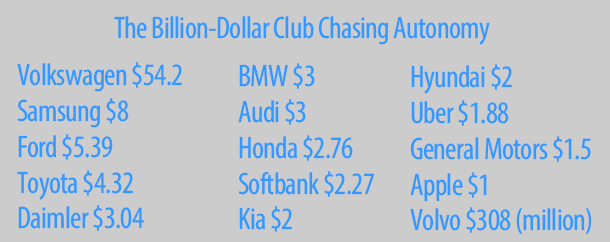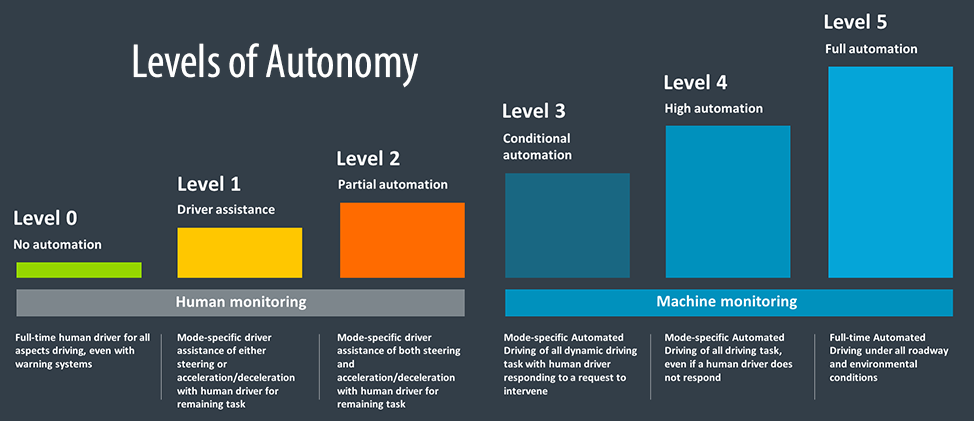
Elusive Level 5
Way Not Ready for Prime Time: Self-Driving Cars
Could it be that Level 5 self-driving vehicles may not be the solution we really need? What happened to all the research that says computers, AI, and humans "together" are the best-of-all teams?
With $50-plus billion in on autonomy to date, VW Autonomy’s Alex Hitzinger says of Level 5: “This is one of the hardest problems we have. This is like we are going to Mars. Maybe it will never happen.”

The quest for attaining Level 5 self-driving vehicles (see chart) is looking very remote these days. With over $100 billion already spent in pursuit of self-driving tech (2014-2019), and billions more pledged by industry and private investors, full automation, much sought after for Level 5 autonomy, looks to be a distant prospect.

Double whammy
Car manufacturers are rearranging timetables and checking their bank accounts. Everyone is rethinking what it will take to master autonomous driving. We may well see 7-Eleven stores on Mars before Level 5 self-driven vehicles make it to our public streets and highways.
“We overestimated the arrival of autonomous vehicles,” Ford’s chief executive, Jim Hackett, said at the Detroit Economic Club in April.
VW’s Thomas Sedran told Reuters that attaining Level 5 was akin to “a manned mission to Mars.”
Ooops, there’s Mars again. Now we find out that Ford and VW will pool resources and work together, joined by Pittsburgh’s Argo.AI, to get to Level 5. They are not alone. Collaboration mode is on tap for many others as well.
In addition to most every large and small auto maker being eye-ball deep in the self-driving fray, “venture firm Comet Labs mapped startups working on pieces of the autonomy puzzle and found some 263 firms involved.” Ford ponied up $1 billion for startup Argo.AI.
If Level 5 is found to be folly, it may well be too big to stop, even if everyone admits that they’re all simultaneously making Edsels.
Maybe Level 5 is best left for vehicles meant for people-free zones like mining, marine surface and subsea vessels, or deep space exploration? Or, of course, the military, for whom $80 billion is pocket change.
For conspiracy theorists, auto makers pursuing Level 5 might be seen as being totally military research in disguise; the old technique of hiding in plain sight, with even the tech developers ignorant as to the ultimate purpose or customer.
It seems the only military out in the open about its self-driving intent is Russia. YouTube is filled with Vladimir Putin applauding everything from humanoids riding motorcycles to autonomous vehicles firing rockets and machine guns.
Then too, is Level 5 driverless autonomy counter to research about humans, computers and AI being a best-of-all team? Maybe human-in-the-loop driving (accompanied by an AI-infused computer) is the better, safer (yes, safer) choice?

The research says…
On my desk is a stack of research reports from academia and private industry—some of the biggest names in both—that have spent large dollars, time and brainpower writing report after report that a human, together with an AI-infused computer is so much better at doing most anything than a human or an AI-infused computer alone.
For instance, some reports contend that if Garry Kasparov had used a laptop while playing chess against IBM’s Big Blue in 1993, he would have won…easily; same goes for Lee Se-dol using an AI-infused laptop battling DeepMind’s AlphaGo. He would have also won.
So, the research is saying that three together working in concert, like The Three Amigos, is far better than a computer or artificial intelligence or a human acting alone. That goes for both machines and processes.
Seems to make sense.
However, by extension, is it then reasonable to assume from all this research that an AI-enabled computer and a human together are much better at driving a car than either is alone? Or, what makes a car so special that it can get along just fine—or better!—with only two of the three?
Although there is the annual carnage of car accident maimings and deaths needing a permanent solution, as well as traffic efficiencies, environmental benefits, and the potential for shorter commute times all swirling around as reasons for Level 5 autonomous vehicles, Bryan Salesky, Argo.AI’s CEO (now owned by Ford & VW) admitted that the industry’s bigger promise of creating driverless cars that could go anywhere was “way in the future.”
The road carnage solution may have to be rejiggered for human-in-the-loop resolution.
In fact, “Salesky said Argo and many competitors had developed about 80 percent of the technology needed to put self-driving cars into routine use — the radar, cameras and other sensors that can identify objects far down roads and highways. But the remaining 20 percent, including developing software that can reliably anticipate what other drivers, pedestrians and cyclists are going to do, will be much more difficult.”
Top speed for most self-driving vehicles now being tested on public roadways is 25 mph, slower than my grandmother. Faster speeds require more sophisticated and more expensive gear, says Alisyn Malek, COO of May Mobility, operator of autonomous shuttles (the size of golf carts).
So, the 60,000 minivan order that Alphabet was to make for its robotaxis may have to be put on the back burner for “way in the future”.
Put a hold on Knight Rider’s KITT for now
Maybe what’s needed is an intermediate step, something in-between Level 4 and Level 5, maybe a pre-Level 5 step with a human in the loop wearing a mandatory AI-infused head-up display (HUD)—think, fancy Google Glass.
Maybe the HUD tracks the wearer’s eye movements, matching them to what the auto’s sensors see on the road ahead. Alarms go off—or the car stops—if there’s a mismatch or the driver’s pulse rate suddenly jumps up.
One thing is obvious: Level 5 is way out there; so what next?
Before Knight Rider’s advanced “artificially intelligent, self-aware and nearly indestructible” Pontiac Trans Am hits the motoring scene, humans may need to play a much larger role in self-driving’s evolution.
